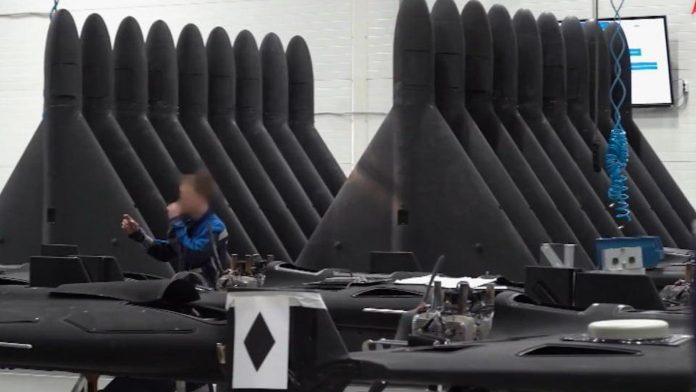When Russia launched its full-scale invasion of Ukraine in early 2022, drones were a footnote in the Kremlin’s military playbook. Three and a half years later, and unmanned aerial vehicles (UAVs) are becoming the centerpiece of Russia’s battlefield operations. What began with limited deployment escalated into the mass production of thousands of attack drones each month, with upgraded technology and revamped tactics responsible for the majority of combat-related injuries and deaths.
A rare glimpse inside Russian drone factory
Russia’s state-run Zvezda TV recently aired a documentary showcasing one of Moscow’s most secretive military-industrial sites: the Alabuga drone factory in the Tatarstan region. It’s a little more than 600 miles from Ukraine’s border, and the facility produces Russia’s Geran-2 drone, which is a version of Iran’s Shahed one-way attack drone.
Footage revealed rows of black drones, workers assembling components, and even teenagers — some as young as 14 — involved in the manufacturing process. The factory reportedly operates a nearby technical college to train future workers straight out of ninth grade. The exact production numbers are classified, but the factory’s director claimed output increased ninefold from initial plans.
Zvezda portrayed the facility with upbeat music and patriotic overtones, part of an effort to maintain public support for the war. But beyond the propaganda lies a hard military reality: The Alabuga plant is now one of the world’s largest producers of strike drones, and its output is fueling a brutal air war over Ukraine.
Iranian design, Russian manufacturing
The Geran-2 drone is modeled on Iran’s Shahed design, and while Russia now manufactures most components domestically, it still depends on Iranian technology and expertise. In 2022, Russia received its first batch of Iranian drones under a $1.7 billion deal. In early 2023, Iran sent hundreds more disassembled Shaheds for reassembly in Russia. Eventually, Alabuga localized production and began iterating on the design.
Recently, the remnants of downed drones recovered in Ukraine showed just how far the technology has come. One drone contained an advanced AI computing platform, a high-resolution camera, a radio link for real-time remote piloting from Russia and Iranian-made anti-jamming technology. Unlike early Shaheds, which could neither track moving targets nor adjust course after launch, this version is fully steerable, jam-resistant and capable of mid-flight retargeting.
“Previous drones often just circled until they crashed,” said David Albright of the Institute for Science and International Security. “Now they’re harder to shoot down and much more effective.”
A tactical shift: Drones as decoys and weapons
Russia isn’t just building better drones, it’s also using them more strategically. Nearly every night, waves of UAVs swarm Ukrainian cities. Not all are armed, though. Some are decoys, designed to exhaust Ukraine’s air defenses before munitions-laden drones or cruise missiles follow.
This saturation tactic is proving effective. Analysis of Ukrainian air force data by The Associated Press shows a rising success rate for Russian drone strikes: from about 6% of drones hitting targets in late 2024 to around 16% in June 2025. On some nights, nearly half reach their destination.
The U.K. Ministry of Defense noted Russia’s increasing use of drones at both high altitudes to evade small arms fire and low altitudes to avoid radar detection. These shifting tactics, combined with upgraded hardware, are straining Ukraine’s ability to respond.
The Iranian connection
Despite recent Israeli airstrikes on Iranian military facilities, including drone factories, it’s still unclear how much Tehran’s drone pipeline to Moscow was disrupted. Western intelligence agencies, including the U.K.’s Defense Ministry, say the strikes will likely “negatively impact” Iran’s ability to supply Russia. But the damage may not be enough to curtail the Kremlin’s drone war, especially as Russia continues to bolster domestic production.
Much of Iran’s technology and expertise has already been transferred to Russia. Leaked documents and investigations reveal that Iranian engineers helped launch Alabuga’s production, and Russia experimented with features like jet engines and thermobaric warheads. That type of munition is capable of causing devastating internal injuries by sucking the oxygen out of enclosed spaces.
“We’re seeing drones with features previously only used in Iranian missile programs,” said Serhii Beskrestnov, a Ukrainian electronics specialist. “These are not just copies — they are upgrades.”
The broader challenge for democracies
The surge in drone warfare represents more than a shift in one conflict. A recent white paper by the Center for Strategic and International Studies argues that the modern battlefield is now defined by the “persistent erosion of capacity and will” rather than decisive strikes. For democracies, the key challenge is adapting quickly enough to counter adversaries like Russia and Iran, who are rapidly iterating on technology and battlefield application.
For Ukraine, that means more strain on air defense systems and fewer options for intercepting smarter, more agile threats. For the international community, it’s a wake-up call that drones are not just force multipliers, they are shaping the very nature of war.
What comes next?
Russia’s reliance on drones is unlikely to wane, even amid sanctions and shifting alliances. President Vladimir Putin has already called for increased production, and official figures show that output increased by nearly 17% in May alone. Alabuga and other domestic sites appear poised to meet, or exceed, demand.
Still, cracks are beginning to show. The use of teenagers in military manufacturing raises ethical and legal questions. And as Israel targets Iranian drone infrastructure and global scrutiny increases, the drone war’s sustainability could falter.

